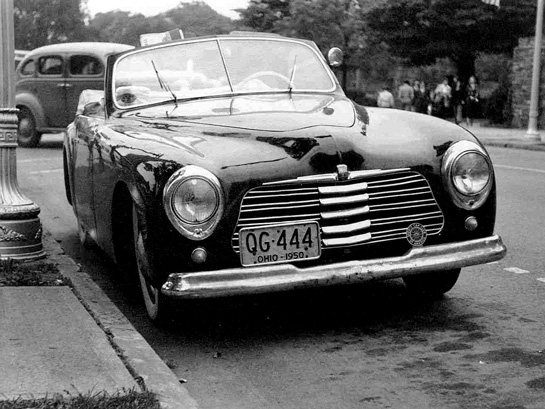
A walk through the streets of Watkins Glen in 1950 would have revealed this Simca 8. Photo by Frank Shaffer.
In this article we have combined recent images of the town of Watkins Glen as it is today with never before published photos of a walk through the town in 1949 and 1950.
By Pete Vack with historic photos by Frank Shaffer
Visiting Watkins Glen is taking a walk—and a drive–through the history of American sportscar racing. Through the efforts of the late Cameron Argetsinger, road racing in U.S. began right here; you can tour the original, dangerous, yet beautiful circuit, virtually unchanged in 59 years. The original and complete circuit consisting of public roads has been not only preserved but protected under the National Register of Historic Places.
Remarkably, one can still drive the original circuit, where races were held from 1948 to 1952. While progress may have snubbed Watkins Glen, it is wonderful to see that the major changes are the size of the trees and new siding on some of the older farm houses. Two miles up the hill from the Start Finish line, stop at the Sam Collier monument, placed where the Cunningham Ferrari 166 left the road in 1950, then dive into the State Park, over the Stone Bridge where Denver Cornett’s MG took a swim in the creek, and through the woods to Archy Smith’s corner, Friar’s Curve and Big Bend, which is in fact a very long, long curve. Finally, one ends up back into town after Milliken’s Corner, where Bill rolled his Bugatti Type 35A in 1948.
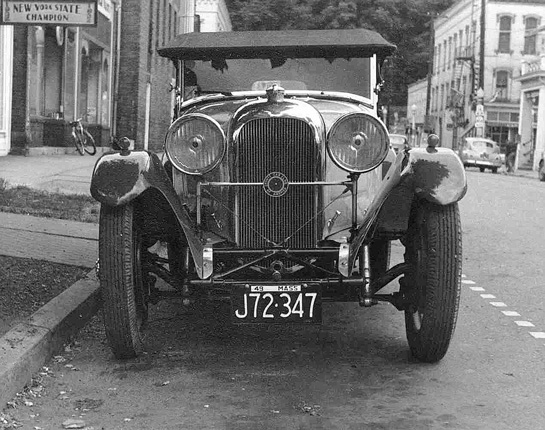
Then: Readers say this in not an Aston Martin but a Lagonda Rapier, 1933-34. On the streets of the Glen. Photo by Frank Shaffer.
The town of Watkins Glen is full of historical items for the car enthusiast. The Seneca Harbor Station at the end of Franklin Street offers a great view of Lake Seneca, outside seating (in good weather) and good food at reasonable prices. From here you can walk back down Franklin Street and begin to enjoy race history, embedded into the sidewalks and painted on available building walls.
The mural of the Milliken Bugatti at 200 N. Franklin will catch your attention, and on the next building, another mural, this of the Cunningham of Phil Walters and Bill Spear’s Ferrari 4.5 is even more impressive. Both are brilliantly painted by noted artist Robert Gillespie. Walking further south, keep your eye on the sidewalk, for here lie the 55 markers of the Drivers Walk of Fame.
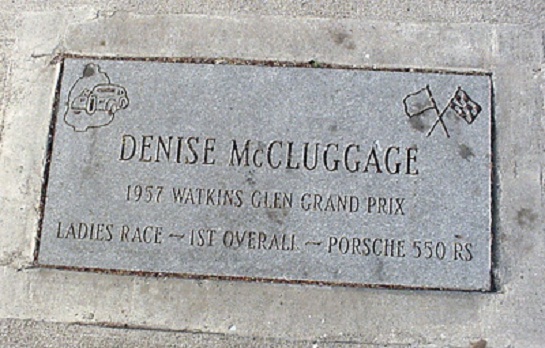
Now: Denise McCluggage is among the many drivers who are honored with markers on the sidewalks of Franklin Street.
Walk all the way down Franklin Street to the corner of Old Corning Hill Road. Just before the intersection, on the left, is the sight of the fatal accident which took the life of young Frank Fazzari in 1952 and ended the first era of racing at the Glen. Across the bridge, still on the left going south, is Smalley’s Garage, a landmark with a living history. Established by Lester Smalley in 1941, the his wife Flossie performed tech inspections for the race cars from 1949 to 1960. Much like it was in the early fifties, the garage is still a very active business, now run by Lester’s son Tom.
What’s even more interesting is to compare the old circuit with the current Watkins Glen International racetrack, located off of Route 16. During the lunch hour from May to October, buy a ticket for $25 which allows you to tour the track for three laps. The laps are led by a pace car, however, and motorcycles need not apply.
Take a break, for your next visit will probably take in a half a day or more. Driving south on Franklin, turn left on 14th street and you will find the IMRRC, open 9-5 Monday-Saturday. Around and above the display of significant cars such as the Ferrari 375 are the books, files, collections, and magazines devoted entirely to our favorite subject. Meet Mark Steigerwald, resident Reference Librarian, and noted historian Bill Green, and spend hours finding and enjoying those rare books on Ferraris which you should have bought when first published.
The library now has over 2500 book titles, with more being added every day. The second floor houses the collection of 110 magazine titles, most in complete sets. There are always knowledgeable people to help you find what you are looking for. Or sit down in the film room and enjoy a rare racing video from a selection of almost 3000.
There is no other library in the U.S. which exceeds the material housed in the IMRRC. If there were nothing else to see in Watkins Glen, the IMRRC is reason enough to make the pilgrimage.
For more information about the IMRRC click here.
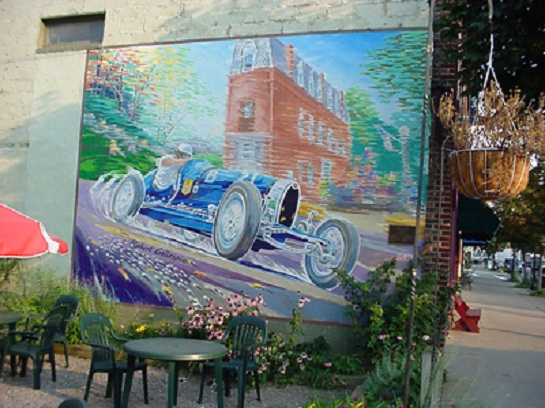
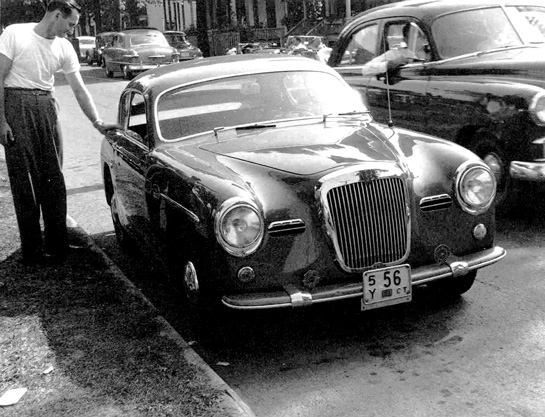
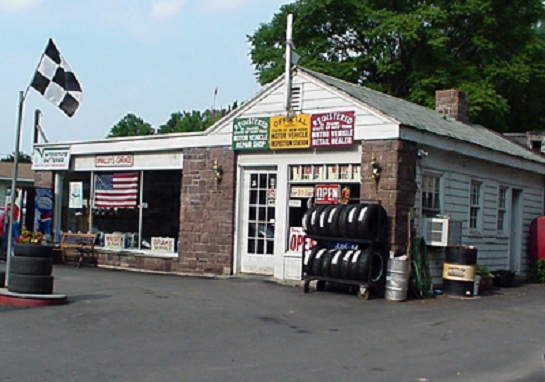
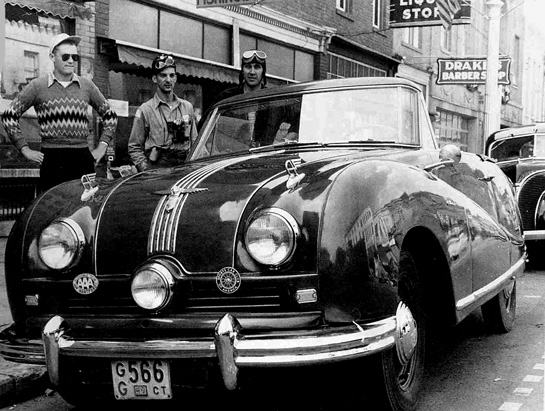
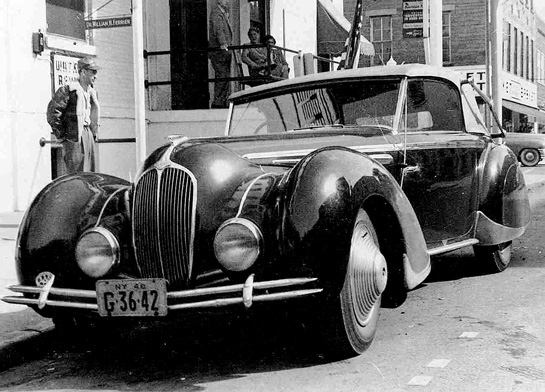
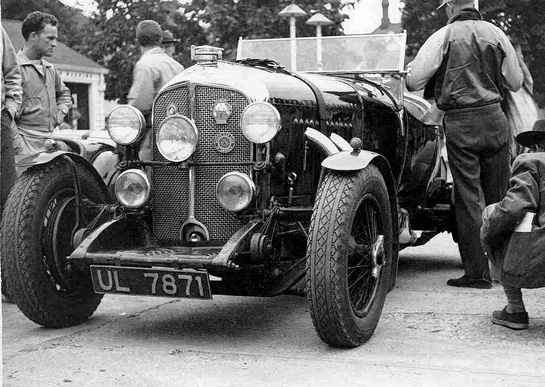
1950 + ah yes, i was there.
spectator, not contestant yet.
ithaca was only a few miles away.
two of my classmates lived in burdett, just up the street.
another lived in hector, a few miles farther on.
no dinero means not contestant.
> jack
“The Italian Aston Martin, designed by A.C. Bertelli ” in one of your photos is in fact a Lagonda Rapier from 1933-35. All looks correct except for the telescopic shock absorbers. I’m the owner of a Rapier ( a few were made after the demise of Lagonda, all with superchargers). The cars have a sophisticated twin overhead cam engine of 1100cc and a pre-selector gear box. Great brakes (girling) and excellent handling mean that the cars are good for vintage racing.
Excellent! More “Then and Now” historical articles like this please.
Pete,
What a delight to open up “Veloce” and see a picture of the late Dick Gent’s Simca Sport taken on the street at Watkins Glen staring me in the face!
In those lovely days before lawyers (and the debacle to come on Franklin Street) it was possible for Richard W. Bosley (of the Bosley Special cars fame — and my brother’s college room mate), Bob Morris (the other college room mate) and myself to “borrow” this car for a quick “reconnoiter” of the circuit. Everything was cool, except for the embarrassing bit of the photgrapher catching us down near “Punchbowl Lake” and the “Stone Bridge”. Oops!
James,
I sure can’t disagree–even blown up I can’t make out a badge. My guess was a AM based on the grille. Thanks very much for your comment and correction—
Ed.
What a lovely sight of a Simca from Iowa with an ungainly Plymouth/Oldsmobile whatever in the back ground. No wonder as a kid of 13 years old I fell in love with “foreign cars”! Imagine what I felt when I saw my first Ferrari 340 America in the “flesh” at Elkhart Lake in 1951, and it wasn’t even red!
Brad
1950 was my first visit to Watkins Glen races. And coming back in 1959, as well as several times during the early 80’s while managing my company’s IMSA program with Jerry Thompson racing our #11 IPC Camaro, plus a few times since to enjoy the vintage machinery being exercised, has never recaptured that experience. Armed with my trusty Kodak 620 “Tourist” folder, I caught enough decent images for J.J. O’Malley to include three of them in “The Glen-’98”, his 50-year recap. The one taken of Erwin Goldschmidt’s Cad-Allard from behind battered haybales on the outside of the first turn reminds me of where I should NOT have been standing. In the background is the spot where a youngster was pushed into peril just two years later.
My wife and I drove ’round the original course again just a few years ago while detouring on a trip to New England. Other than thicker tree trunks, most of it hardly looks a bit different and the downhill view of Seneca Lake is still fabulous.
Thanks for the memories.
To Jack Gordon, the first responder to the Watkins Glen report. I was there too, when you were at Cornell. If you recall, we were touring through Europe in my Porsche in 1958.
You are, I hope, the same Jack Gordon who raced an OSCA at LeMans with John Bentley?
How can I contact you?
Jerry Lehrer
Hello,I was pleased to see the photo of Lagonda Rapier J72-347 on Watkins Glen.
I now own this car which is now in southern England,imported in 2009.
Does anyone know any history of the car? could it have been in the street race? is there any way to find out? If you would like any photos of the car,its still unrestored and original, give me an ‘e’ mail address and I will send some.
Best wishes Steve. stephen.lamonby@gmail.com